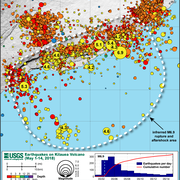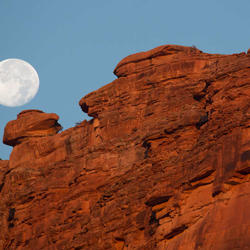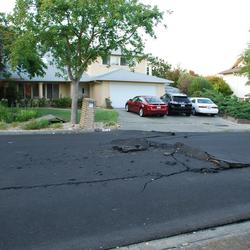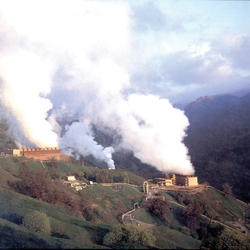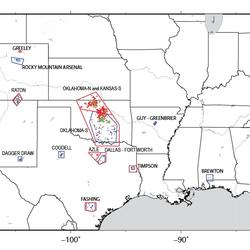Map showing aftershock zones of great Aleutian Islands, Alaska, earthquakes in the 20th century. Red solid line with pink fill indicates aftershock zone of the 1957 Aleutian Islands earthquake from Sykes et al.
What is the difference between aftershocks and swarms?
Aftershocks are a sequence of earthquakes that happen after a larger mainshock on a fault. Aftershocks occur near the fault zone where the mainshock rupture occurred and are part of the "readjustment process” after the main slip on the fault. Aftershocks become less frequent with time, although they can continue for days, weeks, months, or even years for a very large mainshock.
A swarm, on the other hand, is a sequence of mostly small earthquakes with no identifiable mainshock. Swarms are usually short-lived, but they can continue for days, weeks, or sometimes even months. They often recur at the same locations. Most swarms are associated with geothermal activity.
Learn more: Aftershocks? Swarm? What is the difference, and what do they mean?
Related
What is an earthquake and what causes them to happen?
Foreshocks, aftershocks - what's the difference?
Can the position of the moon or the planets affect seismicity? Are there more earthquakes in the morning/in the evening/at a certain time of the month?
What is surface faulting or surface rupture in an earthquake?
At what depth do earthquakes occur? What is the significance of the depth?
Why are there so many earthquakes in the Geysers area in Northern California?
Do earthquakes occur in Antarctica?
Where can I find earthquake educational materials?
Can we cause earthquakes? Is there any way to prevent earthquakes?

Map showing aftershock zones of great Aleutian Islands, Alaska, earthquakes in the 20th century. Red solid line with pink fill indicates aftershock zone of the 1957 Aleutian Islands earthquake from Sykes et al.

A technician installs strong motion and high frequency sensors April 11 at a station selected to record aftershock data from the April 5, 2024 Whitehouse Station, N.J. earthquake.
A technician installs strong motion and high frequency sensors April 11 at a station selected to record aftershock data from the April 5, 2024 Whitehouse Station, N.J. earthquake.

U.S. Geological Survey electronics technician Greg Tanner installs an "aftershock kit" in New Jersey April 10 following the April 5, 2024 Whitehouse Station earthquake.
U.S. Geological Survey electronics technician Greg Tanner installs an "aftershock kit" in New Jersey April 10 following the April 5, 2024 Whitehouse Station earthquake.
May 2020 earthquake swarm at Lōʻihi seamount
May 2020 earthquake swarm at Lōʻihi seamount

The inferred rupture area (white dashed line) of the May 4, 2018, magnitude-6.9 earthquake, with its foreshocks and first 10 days of aftershocks, spans an area of about 800 sq km (300 sq mi). Circle size indicates earthquake magnitude; color indicates earthquake depth. Magnitudes for some of the larger events are labeled.
The inferred rupture area (white dashed line) of the May 4, 2018, magnitude-6.9 earthquake, with its foreshocks and first 10 days of aftershocks, spans an area of about 800 sq km (300 sq mi). Circle size indicates earthquake magnitude; color indicates earthquake depth. Magnitudes for some of the larger events are labeled.

December 13 - 14, 2016 Long Valley Caldera earthquake swarm recorded on instrument MDH1 webicorder. Swarm begins at 23:28 PST.
December 13 - 14, 2016 Long Valley Caldera earthquake swarm recorded on instrument MDH1 webicorder. Swarm begins at 23:28 PST.
Aftershocks are earthquakes that follow the largest shock of an earthquake sequence. They are smaller than the mainshock and within 1-2 fault lengths distance from the mainshock fault. Aftershocks can continue over a period of weeks, months, or years.
Aftershocks are earthquakes that follow the largest shock of an earthquake sequence. They are smaller than the mainshock and within 1-2 fault lengths distance from the mainshock fault. Aftershocks can continue over a period of weeks, months, or years.
Aftershock forecasting
Earthquake information products and tools from the Advanced National Seismic System (ANSS)
On the potential duration of the aftershock sequence of the 2018 Anchorage earthquake
Natural Hazards Science at the U.S. Geological Survey
The 11 April 2012 east Indian Ocean earthquake triggered large aftershocks worldwide
Fundamental questions of earthquake statistics, source behavior, and the estimation of earthquake probabilities from possible foreshocks
Earthquake hazards: A national threat
The USGS Earthquake Hazards Program - investing in a safer future
Foreshocks and aftershocks of the great 1857 California earthquake
The severity of an earthquake
This dynamic earth: the story of plate tectonics
Related
What is an earthquake and what causes them to happen?
Foreshocks, aftershocks - what's the difference?
Can the position of the moon or the planets affect seismicity? Are there more earthquakes in the morning/in the evening/at a certain time of the month?
What is surface faulting or surface rupture in an earthquake?
At what depth do earthquakes occur? What is the significance of the depth?
Why are there so many earthquakes in the Geysers area in Northern California?
Do earthquakes occur in Antarctica?
Where can I find earthquake educational materials?
Can we cause earthquakes? Is there any way to prevent earthquakes?

Map showing aftershock zones of great Aleutian Islands, Alaska, earthquakes in the 20th century. Red solid line with pink fill indicates aftershock zone of the 1957 Aleutian Islands earthquake from Sykes et al.
Map showing aftershock zones of great Aleutian Islands, Alaska, earthquakes in the 20th century. Red solid line with pink fill indicates aftershock zone of the 1957 Aleutian Islands earthquake from Sykes et al.

A technician installs strong motion and high frequency sensors April 11 at a station selected to record aftershock data from the April 5, 2024 Whitehouse Station, N.J. earthquake.
A technician installs strong motion and high frequency sensors April 11 at a station selected to record aftershock data from the April 5, 2024 Whitehouse Station, N.J. earthquake.

U.S. Geological Survey electronics technician Greg Tanner installs an "aftershock kit" in New Jersey April 10 following the April 5, 2024 Whitehouse Station earthquake.
U.S. Geological Survey electronics technician Greg Tanner installs an "aftershock kit" in New Jersey April 10 following the April 5, 2024 Whitehouse Station earthquake.
May 2020 earthquake swarm at Lōʻihi seamount
May 2020 earthquake swarm at Lōʻihi seamount

The inferred rupture area (white dashed line) of the May 4, 2018, magnitude-6.9 earthquake, with its foreshocks and first 10 days of aftershocks, spans an area of about 800 sq km (300 sq mi). Circle size indicates earthquake magnitude; color indicates earthquake depth. Magnitudes for some of the larger events are labeled.
The inferred rupture area (white dashed line) of the May 4, 2018, magnitude-6.9 earthquake, with its foreshocks and first 10 days of aftershocks, spans an area of about 800 sq km (300 sq mi). Circle size indicates earthquake magnitude; color indicates earthquake depth. Magnitudes for some of the larger events are labeled.

December 13 - 14, 2016 Long Valley Caldera earthquake swarm recorded on instrument MDH1 webicorder. Swarm begins at 23:28 PST.
December 13 - 14, 2016 Long Valley Caldera earthquake swarm recorded on instrument MDH1 webicorder. Swarm begins at 23:28 PST.
Aftershocks are earthquakes that follow the largest shock of an earthquake sequence. They are smaller than the mainshock and within 1-2 fault lengths distance from the mainshock fault. Aftershocks can continue over a period of weeks, months, or years.
Aftershocks are earthquakes that follow the largest shock of an earthquake sequence. They are smaller than the mainshock and within 1-2 fault lengths distance from the mainshock fault. Aftershocks can continue over a period of weeks, months, or years.



